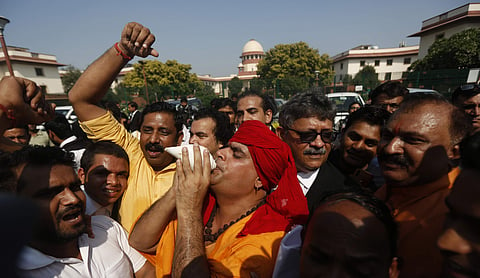

‘Desecration’ of mosque led to suit
According to the plaintiffs, the cause of action for the suit arose on 23 December 1949 when the Hindus are alleged to have wrongfully entered the mosque and desecrated it by placing idols inside the mosque.
The injuries are claimed to be continuing in nature. As against the state, the cause of action is alleged to have arisen on 29 December 1949 when the property was attached by the City Magistrate who handed over possession to the receiver. The respondent assumed charge on 5 January 1950.
Legal personality conferred on Hindu idols
In addition to the continued worship of the deity, legal personality is conferred on Hindu idols to provide courts with a conceptual framework within which to practically adjudicate disputes involving competing claims over disputed property endowed to or appurtenant to Hindu idols.
In order to adjudicate disputes, the court locates a site of jural relations to determine proprietary claims, maladministration by shebaits and protect the interests of devotees.
The law thus protects the properties of the idol even absent the establishment of a specific or express trust. In the proceedings before us, the legal rights and properties of the first plaintiff in Suit 5 were in dispute.
However, no submissions were made challenging the legal personality of the first plaintiff. Significantly, Dr Rajeev Dhavan, learned Senior Counsel appearing for the plaintiffs in Suit 4 admitted the juristic personality of the first plaintiff.
The question of the legal personality of the first plaintiff is distinct from the properties that appertain to the first plaintiff.
Land worshipped as deity
The decisions and their observations which have been adverted to are premised on the existence of a positive act of dedication or donation.
It is pertinent to note that plaintiffs‘ claim for the conferment of juristic personality on the land that is the disputed site is not based on an express dedication.
It was urged that the spot under the central dome where the idols are placed is the birthplace of Lord Ram. The faith and belief of the worshippers is of paramount importance.
Hindus perform the parikrama around the disputed site with the faith and belief that it marks the birth-place of Lord Ram.
It has thus been argued that ‘Asthan Shri Ram Janam Bhumi’, as a place of religious worship must consequently be elevated to the status of a juristic person by virtue of the faith and belief of the worshippers. It was contended that the presence of an idol is dispensable in Hinduism, this contemplates a situation such as in the case before us, where the land is itself worshipped as a deity.
Five acres for Sunni Wakf board
The area of the composite site admeasures about 1500 square yards. While determining the area of land to be allotted, it is necessary to provide restitution to the Muslim community for the unlawful destruction of their place of worship.
Having weighed the nature of the relief which should be granted to the Muslims, we direct that land admeasuring 5 acres be allotted to the Sunni Central Waqf Board either by the Central Government out of the acquired land or by the Government of Uttar Pradesh within the city of Ayodhya.
Muslims wrongly deprived
The exclusion of the Muslims from worship and possession took place on the intervening night between 22/23 December 1949 when the mosque was desecrated by the installation of Hindu idols.
The ouster of the Muslims on that occasion was not through any lawful authority but through an act which was calculated to deprive them of their place of worship.
After the proceedings under Section 145 of CrPC 1898 were initiated and a receiver was appointed... worship of the Hindu idols was permitted.
During the pendency of the suits, the entire structure of the mosque was brought down in a calculated act of destroying a place of public worship. The Muslims have been wrongly deprived of a mosque...
God’s blessings sufficient to make it a temple
The observations of the court were made in the context of assessing whether the presence of an idol was required for the institution to be defined as a temple under Section 9 of the Madras Hindu Religious Endowments Act, 1926.
It was in this context that the court held that the belief of the devotees that they will be the recipients of God‘s blessings was sufficient for the institution to be held a temple under the Act.
At best, these observations of the court establish that the belief of devotees that there is a divine presence is constitutive of a place of public worship.
This, however, is distinct from the conferral of juristic personality. An adjudication that an institution is a temple for the purposes of a statutory enactment is distinct from the issue as to whether the institution possesses juristic personality.
The observations, in this case, were made in the specific context of a statutory definition and cannot be applied to a place a religious worship for which no statutory enactment exists.